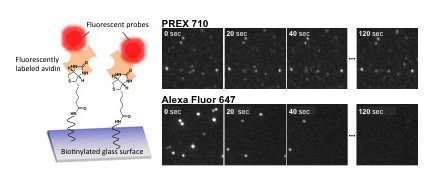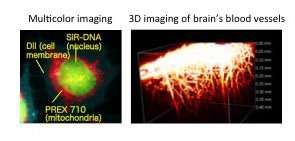A near-infrared fluorescent dye for long term bioimaging

A group of chemists at the Institute of Transformative Bio-Molecules (ITbM), Nagoya University, has developed a new near infrared (NIR) emitting photostable fluorescent dye PREX 710 (photo-resistant xanthene dye which can be excited at 710 nanometers) to have uses ranging from long term single molecule imaging to in vivo deep imaging, according to a study reported in the journal Angewandte Chemie International Edition.
PREX 710 has a molecular structure consisting of a phosphine oxide (P=O) moiety in the place of oxygen in its fused tricyclic xanthene core, and 2 methoxy (OMe) groups on the peripheral aromatic ring, which enables the dye to absorb and emit in the NIR region, and accounts for its high chemical and photostability, respectively. In addition, the PREX 710 NHS ester can be chemically linked to biomolecules including proteins, sugars, and small organic ligands, which can lead to observations of various structures and events in live cells.
Together with the researchers of RIKEN and Ehime University, the team has found that PREX 710 could be used for single molecule fluorescent imaging under physiological conditions. The high photostability of PREX 710 enables repeated imaging, and its specific light absorption/emission properties in the NIR region, allows multicolor imaging with its use with other fluorescent dyes. Moreover, by linking PREX 710 NHS ester to a polysaccharide (dextran), the team succeeded in the 3-D deep in vivo imaging of blood vessels in mice brains. This was made possible by the high chemical stability of PREX 710 within the blood stream, as well as by the use of NIR radiation to look deep inside the tissues. The high photostability, water solubility and chemical stability, along with its low cytotoxicity, and use of NIR radiation makes PREX 710 a powerful tool for visualizing molecular processes and structures for long durations without photobleaching inside living organisms.
Fluorescence imaging is a technique where a specific protein or cell organelle is labeled with a fluorescent probe and is used to visualize processes and structures of organisms under a fluorescent microscope. Although many fluorescent labeling agents, such as fluorescent proteins and small fluorescent organic molecules have been developed up to now, most of them use radiation in the visible region. The disadvantages of using visible light such as blue or green lights arise from its high energy, which may cause damage to living samples when they are exposed for long periods. In addition, when the samples are excited with visible light, autofluorescence from the samples themselves tend to interfere with the signals from the fluorescent probes. It is also known that biomolecules such as hemoglobin tend to absorb visible light, so the light does not reach deep inside the organisms, which has made is difficult to visualize live blood vessels and organs.

These issues arising from imaging with visible light could be overcome using NIR radiation, which has a longer wavelength, thus lower energy, compared to visible light. Nonetheless, many of the NIR dyes developed so far are based on cyanine dyes, which consist of polymethine chains (methine (CH) groups connected by alternating single and double bonds) that have nitrogen-containing heterocycles attached to each end of the chain. The majority of the cyanine dyes suffer from low chemical and photostability, thus making long term bioimaging difficult with these dyes due to photobleaching over time. Although anti-fading agents may be added to prevent photobleaching, they may not be applicable in live cell experiments.
"The Yamaguchi group has been interested in making photostable dyes for bioimaging that absorb and emit in different wavelengths," says Dr. Masayasu Taki, an Associate Professor in Professor Shigehiro Yamaguchi's group at ITbM, and one of the leaders of this study. "It is known that the excitation and emission wavelengths of dyes increase with an increase of conjugated double bonds in its structure, but more rings makes the synthesis complicated and also leads to low water solubility, which is not ideal for imaging under physiological conditions. We therefore decided to synthesize different dyes by changing the elements on the core xanthene ring from oxygen to phosphorus."
"Dr. Marek Grzybowski, a postdoctoral researcher in our group, has been working on this project, and has devised the syntheses of many of the rhodamine-based fluorescent dyes recently developed in our group," describes Taki.
During their studies, the group also found that one of the derivatives of PREX 710 was susceptible to attack towards a reduced form of glutathione (GSH), which is a tripeptide that acts as an antioxidant in cells. Although decolorization of dyes by GSH is generally considered to be a drawback in fluorescent live imaging, the group figured that this dye could serve as a promising NIR probe to monitor the GSH level in living cells and tissues.

"After synthesizing and testing various xanthene derivatives, we found PREX 710, which exhibited exceptional chemical and photostability, and thus proved to be a practical NIR-emissive fluorophore, which itself is membrane-permeable and mainly localizes in the mitochondria of living HeLa cells," explains Taki. "We were really excited to see that by using PREX 710, we could visualize live cell components for many minutes compared to only a few seconds that could be achieved with conventional dyes."
In collaboration with Dr. Yasushi Okada, a team leader at the RIKEN Center for Biosystems Dynamics Research, the team found PREX 710 to be applicable for single molecule fluorescent imaging, a technique that is known to require strong light radiation. Their studies show that under the same experimental conditions, 80% of the single molecule fluorescent signals from PREX 710 could be detected for 2 minutes, whereas half of the signals disappeared within 20 seconds with Alexa Fluor 647 (cyanine dye). The experiments demonstrate that PREX 710 can clearly visualize each single molecule for prolonged periods without any photobleaching in the absence of anti-fading agents.
In addition, the team was able to make use of PREX 710 in the multicolor imaging of live HeLa cells. Since the NIR excitation and emission properties of PREX 710 differ from visible light fluorescent dyes, spectral crosstalk can be avoided in order to visualize cell components each stained with different dyes. For example, multicolor imaging of live HeLa cells was possible upon staining the cell membrane, nucleus and mitochondria with commercially available fluorescent dyes such as DiI and SiR-DNA, along with PREX 710, respectively.
The practical utility of PREX 710 was also demonstrated by applying the probe for the in vivo deep imaging, which was carried out in collaboration with Drs. Takeshi Imamura and Ryosuke Kawakami of Ehime University. Using the bioconjugation site of PREX 710, dextran, a polysaccharide composed of glucose molecules, was fluorescently labeled and injected into the bloodstream via the mouse tail vein. The 3-D image of blood vessels in mouse brain could be constructed due to the high brightness of PREX 710 in the NIR region that enables recording of the fluorescence signals in deep tissue.
"We were pleased to demonstrate that PREX 710 and its derivatives are useful tools for the investigation of the dynamics of living organisms, tissues, cells, and molecules," says Taki. "We are currently working on developing other NIR fluorescence probes that could be used for staining specific proteins as well as examining live structures and processes in more depth. We hope that this will lead to the visualization and elucidation of various phenomena in living systems, including medical symptoms," he says.
More information: Marek Grzybowski et al. A Highly Photostable Near-Infrared Labeling Agent Based on a Phospha-rhodamine for Long-Term and Deep Imaging, Angewandte Chemie International Edition (2018). DOI: 10.1002/anie.201804731
Journal information: Angewandte Chemie International Edition
Provided by Nagoya University





















